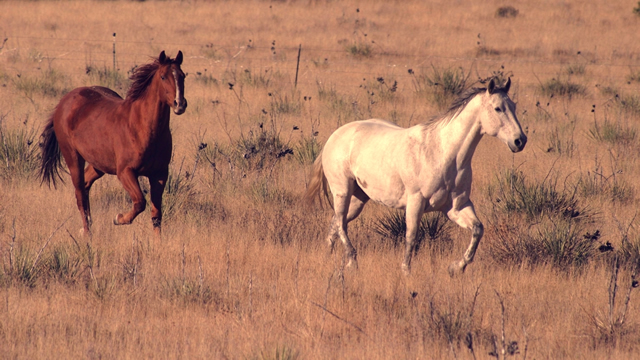Written by Sue Stuska, Ed.D.
We each know our horse better than anyone else, we see him more often, and we already have the ability to detect when our horse is “off.” This discussion will help you fine-tune your skills.
Noticing Lameness
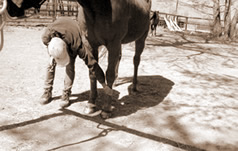 Lameness is often the way we find out that something is wrong. Other evidence may include heat, swelling or a tiny wound that you’d notice during grooming; sometimes swelling is significant enough to notice even as your horse stands to eat. However, sometimes heat, swelling or a wound aren’t present, or they aren’t discernible by hand or your eye alone. Since lameness may occur before you detect other symptoms, or without these symptoms, and since lameness can be subtle, it’s important to hone our detection skills.
Lameness is often the way we find out that something is wrong. Other evidence may include heat, swelling or a tiny wound that you’d notice during grooming; sometimes swelling is significant enough to notice even as your horse stands to eat. However, sometimes heat, swelling or a wound aren’t present, or they aren’t discernible by hand or your eye alone. Since lameness may occur before you detect other symptoms, or without these symptoms, and since lameness can be subtle, it’s important to hone our detection skills.
Important Information
We need to know if our horse is lame, and how lame he is. We want to be able to monitor the progress of the lameness: is it getting better or worse? Is it better today after I gave him the day off yesterday? We want to make training or riding decisions. Should I ride or train today-or not? Should I do something less stressful today? You might choose not to go on that long ride, or not to do so much round pen work, but instead to ride on straight lines. We want to make an educated decision on whether to seek veterinary treatment. When in question, call the vet. However, before you call, determine all you can about the lameness.
We want to see if we can gather enough information to determine the reason for the problem, which may influence our decisions or treatment. We want to think back and decide if this problem is acute (suddenly bad) or chronic (an ongoing situation). Does the horse warm up out of it (which sometimes happens with stiffness from a previous hard workout or navicular syndrome)? Is there a pattern, for example, he’s sore after he’s trimmed or shod, or he’s stiff after a day off?
How Can I Tell if My Horse Is Lame?
While the leading/groundwork and riding can be done alone, it’s helpful to have a friend along. She or he can alternately watch and work the horse so you can watch. Trading off helps train your eye and also lets you compare your findings.
Comparing his movement to normal is helpful, so go through these steps when your horse is OK. It’s also valuable to watch other horses move. Conformation and trimming or shoeing contribute to differences in movement; what you’re looking for are differences from that horse’s norm and differences between pairs of legs (hind legs or fore legs).
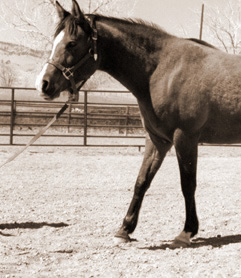
At Rest
Watch how he’s standing. “Pointing,” resting a foreleg out in front of the normal stance, indicates lameness in that limb. The sound foreleg will be vertical, taking most of the weight. Viewed from the side, sore front limbs (particularly if they are both sore) are placed out front while the horse stands more under himself (almost in a leaning posture) with both hind legs.
Resting a hind leg is normal, as long as it’s not always the same leg and done in situations where the horse should not be resting.
An acutely lame horse will hold his hoof in the air; these cases are clearer than others and don’t involve the diagnostic work in this article.
A horse may show you he’s sore by lying down more than usual, by lying down at times or in places where he’d not normally lie down, or he may have trouble rising.
Leading and Groundwork
Listen and watch while you are leading and doing groundwork. Listen for an even 1-2-3-4 walk rhythm with even loading (all footfalls have the same intensity). There should be no hesitation to step out. Working the horse without a rider-and even without a saddle-can remove these as variables. You want to isolate the problem as being in the limbs. A saddle might pinch, or a rider’s weight might make a sore back uncomfortable; you want to concentrate on the legs in this diagnostic work.
Feel While Riding
Sometimes you can feel what you can’t see. Let the horse trot out on loose reins. Feel for evenness. Then take up the reins until you can just barely feel his mouth (don’t restrict his head movement) and feel for uneven neck and head movement. Close your eyes, if you can safely, to concentrate on feel. At trot, post on each diagonal in turn. Then switch back and forth between diagonals and feel for changes in the horse. Then, float or ride out of the saddle in two-point position. Next, sit the trot. Your weight changes might influence the horse to show his lameness problem, and you may be able to feel the lameness better at one riding position than another.
Canter is an inherently uneven gait (one side leads the other). This makes it less useful when comparing limbs while trying to see or feel lameness. However, you can probably feel that one lead has more abrupt landings than the other when that foreleg is sore. New hesitation to take one lead can point to lameness in the initiating hind or the leading front limb. Unwillingness to land on one lead after a jump may show pain in that leading leg.
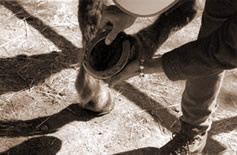
Diagnostic Techniques
Hard Surface
Choose a hard surface because it will emphasize the lameness. You’re not working the horse hard for a long time on the hard surface, but instead are using the surface just long enough to diagnose the problem. Your horse will be more sore when landing on the less forgiving surface. His toes can’t dig in to the ground, so quicker breakover and takeoff can show soreness too-often in the rear of the limb. A hard surface also makes it easier to hear the rhythm and impact-you should hear an even, and evenly weighted, 1-2-3-4 walk and 1-2-1-2 trot.
Smooth Surface
It’s much easier to see unevenness in steps without the distractions of uneven terrain. A paved road, aisle, or hard surfaced drive/parking lot are helpful. Surfaces like asphalt can be slippery, but can be used if you take it easy.
Hills
Moving down a hill will show or increase front leg lameness because the horse puts more weight on these limbs on the slope. Landing will be more uncomfortable, though breakover won’t be (it’s aided by the slope). He may also drop his back and raise his head in an effort to transfer weight to the sound hind legs.
If he’s sore in the hind tendons, ligaments or joints, he may move stiffly or with stilted movement behind. Going downhill in a balanced manner involves increased bending and weight carrying in the hind limbs; if the hind legs are sore, this will show up more clearly as the horse negotiates the hill.
Although not as easy to detect, when the horse is sore in the heel area, he will land toe first. This results in a shorter, toe-stabbing step which may be more obvious going uphill.
These are easiest to see from the side with someone else leading the horse. The horse should move straight up or down the hill.
Trot
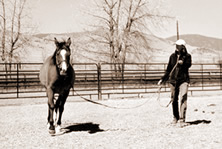
Trot is the diagnostic gait of choice. It is an even gait. The diagonal legs move and touch down together (sometimes not exactly together, but as long as this is consistent, it’s OK).
The trot has enough speed and spring that concussion and propelling forces will usually reveal the lameness. Do move the horse at a long, strong trot instead of a jog because the increased energy and impact will make the lameness easier to detect.
However, because of the diagonal pattern of the trot, it can be difficult to determine which of the diagonal pair is sore-the front limb or the opposite rear limb. Comparing front leg to front leg and hind leg to hind leg on a straight line, or circling the horse, can help you distinguish.
The walk is slower and easier to watch while you practice lameness detection, but walk lacks the impact of trot and the horse’s weight is distributed over three legs much of the time. While a more painful lameness will show at walk, trot will help you detect a more subtle lameness.
Straight Lines
Have your helper lead your horse in straight lines (weaving makes it much harder to detect unevenness). When the horse is coming toward you, his hind legs should be hidden by his forelegs, and vice versa. When the horse is moving across your field of view, he should move straight without weaving. It’s easier to lead in a straight line if you look at an object (a tree or fence post) and move straight toward it. Direct the horse to move on a separate track from the handler so you get a clear view of the horse. Leading toward you, it’s easier when the handler stays out of the way to the side. Leading from side to side past you, it’s easier if the handler is on the far side of the horse.
Be sure the horse is moving freely on a looping lead rope. A taut lead will mask head movement and may make the horse move crooked.
A longer distance gives you more time to get an impression than a short one. You’ll have a number of similar strides to observe without the changes associated with the start and the stop. Stand back far enough to see the whole picture.
Side View
Watching from the side is the best position to detect evenness of leg swings, the flight, forward reach, landing, weight bearing, breakover and takeoff. Watch the horse pass by you as many times as you need. (Consider this legging-up work for your helpful leader!) Sometimes let your eyes soften and take in the whole picture-watch the whole body move. Other times, concentrate with your eyes and ears on just the forelegs, or just the hind legs. Watch for relationships in the movement of the head and neck to the limbs.
Straight Toward, Straight Away
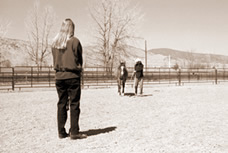 It is also helpful to watch the horse move straight away from and straight toward you. This allows you to watch the flight path of the hind legs and the hip motion, and then watch the front legs. The limbs should move straight forward (within reason; most horses don’t move exactly straight when sound; that’s why it’s useful to do this before the horse becomes lame). A horse with a sore knee, for example, in an effort not to bend the knee as much, may track wider and swing the whole leg outward. A sore hock may be brought more underneath and toward the midline.
It is also helpful to watch the horse move straight away from and straight toward you. This allows you to watch the flight path of the hind legs and the hip motion, and then watch the front legs. The limbs should move straight forward (within reason; most horses don’t move exactly straight when sound; that’s why it’s useful to do this before the horse becomes lame). A horse with a sore knee, for example, in an effort not to bend the knee as much, may track wider and swing the whole leg outward. A sore hock may be brought more underneath and toward the midline.
Circles
Moving the horse in a circle weights the inside legs more. This can accentuate lameness on the inside limbs. This may help you see a lameness problem that doesn’t show up as well on straight lines. You can use circles to help you differentiate which leg is sore because when you circle the horse to the left (counterclockwise), a left (inside) leg lameness will show up more clearly. At trot when the diagonal pairs move together, this can help you differentiate between the relative soundness of the legs in the pair.
It helps to have a helper move the horse in a circle for you. This way you can concentrate on the horse’s movement instead of on guiding him. Also, you can step out of the circle and watch him all the way around without pivoting. While you can use a round pen and do this yourself, the footing in your round pen is probably good and soft and you’ll see more if he’s moving on harder footing. A long line (at least 25′) will allow the horse to move freely forward but still stress him enough to help you see the lameness.
While the horse is circling, you can also watch for lateral (to the outside of the circle) deviation-the hooves or limbs swinging farther out to the side. This occurs when the horse resists bending a sore joint, and is easier to see when you watch a circling horse at the moments he is moving straight toward and straight away from you. Lateral deviation may be more pronounced on a circle than on a straight line.
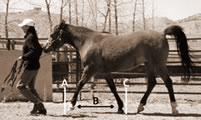
Lameness Clues
Head Motion
Head motion is very diagnostic. If the horse is lame in front, his head and neck will rise as the sore limb or hoof strikes and bears weight. This is a way for the horse to take some of the weight off the sore limb. It may be easier for you to watch, instead, for the head and neck to go down as the sound hoof lands.
If the horse is lame behind, his head will tend to go down as the sore limb or hoof lands. This is also a method of minimizing the weight landing on the sore leg. Head motion is not always the clearest way to diagnose hind limb lameness.
Normally, the horse’s head swings evenly with the movement of the limbs as weight shifts from limb to limb. There is a subtle difference in a lame horse (particularly with front-leg lameness): the head and neck will move less as the sore leg is in motion to minimize the impact.
Hip Motion
Hip motion is also diagnostic but is harder to see. The hip on the sore side may rise during impact of a sore hind leg. This will be easiest for you to see from the rear. Again, this is a way to unweight the sore limb by lifting the hip and transferring weight to the sound legs.
Fetlock Flexion
The fetlock on the sound side will probably dip (flex, or drop) more as more weight is taken on that limb than on the sore one.
Step Differences
Watch and compare front leg to front leg and hind leg to hind leg. Critique the leg flight, forward reach, landing, weight bearing, breakover, and takeoff.
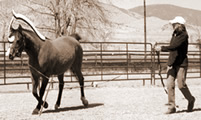
The sore leg will likely stay in the air longer, though it may not be raised any higher (particularly if bending is painful). A sore leg may not reach as far forward. The landing and weight-bearing phase of the sore leg will be shorter than that of the sound leg. The sound limb will land early and dwell on the ground longer. The horse is hurrying the part of the leg movement that hurts and following up more quickly than normal with the sound limb to land and take the weight. The breakover and takeoff of a sore limb may occur sooner, particularly if the problem is a soft tissue injury which is painful to stretch as the limb extends the full way rearward, or if the toe is sore.
The reach of the lame leg may not be as far forward as that of the sound leg; these are easy to compare when watching from the side (a). When the lameness is subtle, detection may be easiest by comparing distances between the limbs when right and then the left legs are forward (b).
If the distances are the same, the horse is moving evenly; if not, there may be a soundness problem. The sore leg may not extend as far back before takeoff (c) as the sound limb. These concepts can also, predictably, be applied to the hind legs.
This article originally appeared in Eclectic Horseman Issue No.5

